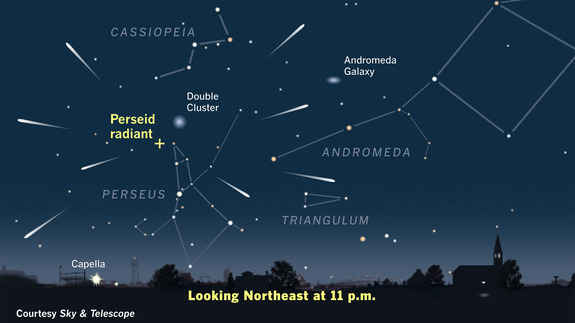The Tears of St. Lawrence
August 11, 2016

TONIGHT and tomorrow night, the spectacular summer display of shooting stars known as the Perseids will be at its peak. If you are fortunate enough to live away from dense urban lights and are in the Northern Hemisphere, you should be able to see as many as 150 of the flaming bits of comet debris every hour in the sky. The moon will set at about 1 a.m. (your local time) tonight and the lights should be especially visible thereafter. You can also watch the meteor shower live online. The meteors appear in all areas of the sky but always streak away from the constellation Perseus; hence their name. The flaming particles are the debris left in the path of the Comet Swift-Tuttle, which takes 130 years to circle the sun; the earth passes through the densest area tomorrow night.
Sarah Lewin writes at Space.com:
Comet Swift-Tuttle is the largest object known to repeatedly pass by Earth; its nucleus is about 16 miles (26 kilometers) wide. It last passed nearby Earth during its orbit around the sun in 1992, and the next time will be in 2126. But it won’t be forgotten in the meantime, because Earth passes through the dust and debris it leaves behind every year, creating the annual Perseid meteor shower.
When you sit back to watch a meteor shower, you’re actually seeing the pieces of comet debris heat up as they enter the atmosphere and burn up in a bright burst of light, streaking a vivid path across the sky as they travel at 37 miles (59 km) per second. When they’re in space, the pieces of debris are called “meteoroids,” but when they reach Earth’s atmosphere, they’re designated as “meteors.” If a piece makes it all the way down to Earth without burning up, it graduates to “meteorite.” Most of the meteors in the Perseids are much too small for that; they’re about the size of a grain of sand.
The spectacle is also sometimes referred to as the “Tears of St. Lawrence,” in honor of the Roman martyr who died in 258 AD and whose feast day was commemorated yesterday, August 10.
The deacon Lawrence is said to have wept when he saw Pope Sixtus II being dragged off by soldiers after the emperor Valerian ordered all deacons, priests and Bishops to be put to death. The Pope asked the young deacon to protect the sacred altar vessels and distribute them to churches and the poor. Lawrence was arrested three days later after he was overheard saying he had treasures. For his refusal to offer up the objects and to sacrifice to the Roman gods, he was roasted alive on a grid iron.
“[T]he fire which burnt outside was less keen than that which blazed within,” Pope St. Leo the Great wrote of the martyr’s death.
St. Lawrence is the patron saint of single men and deacons. He is also, somewhat morbidly, the patron saint of cooks. See more here.
Consider saying a prayer to St. Lawrence if you see one of the falling stars:
Blessed Lawrence said: The darkness is no darkness with me, but the night is as clear as the dawning, that shineth more and more unto the perfect day.
Pray for us, o holy Lawrence!

